|
< Earlier Kibitzing · PAGE 3 OF 3 ·
Later Kibitzing> |
| Nov-03-09 | | CHESSTTCAMPS: <TheN> <<snip> Still, with the pretty much winning White a-pawn, Black is delighted that White was willing to walk into such a mate trap. <snip>> For the sake of argument, suppose the white king is safely on g2. With the white rook in front of the a-pawn, how do you propose to win this ending? |
|
| Nov-03-09 | | jsheedy: Why am I having trouble with this "easy" puzzle? The most promising-looking move is the pseudo-sac 38...Ra7, 40. Re5! (40. Rxa7, e5#), Rxa4+, 41. e4, fxe4, 42. Rxe4, e5+, 43. Kg4, Rxe4, 44. fxe4, Kg6, 45. h4, f5+, 46. Kf3, h5, and maybe Black wins because he has more space. I don't see a KO punch. |
|
| Nov-03-09 | | jsheedy: I wasn't far off. I was looking for a Black win, not a draw, but I saw the rook move ...Ra7. |
|
| Nov-03-09 | | kevin86: I,too was looking for a win-but I saw the crucial move,Ra7. The rook is immune on pain of mate and the valued passed pawn must be lost. I didn't see a win after that,but there wasn't one,anyway. Black DID save a half point. |
|
| Nov-03-09 | | ComboKal: Have patience <Alayo>!!! Not only are some of the posts repetitive (again), but at the time of this reply there is a glitch on page 2 which repeats several of the earlier comments! There is some good stuff here if you sift through the redundancy! Check out <AnalyzeThis> re: G Fuster vs Fischer, 1958 |
|
Nov-03-09
 | | Jimfromprovidence: I didn't like 37 f3, where white basically boxes himself in. I liked 37 e4 better.
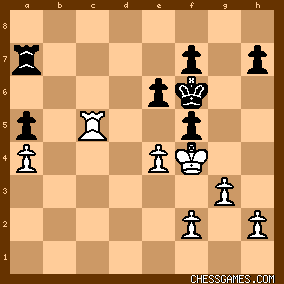
click for larger view
Now, after 37...fxe4 (forced because of the threat 38 exf5), then 38 Kxe4, white's king and rook are very effectively placed. 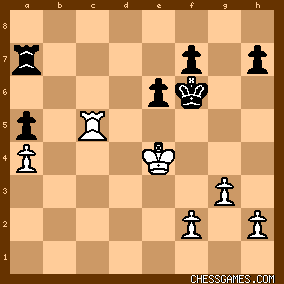
click for larger view |
|
| Nov-03-09 | | Once: We can almost boil this down to a simple recipe:
1. First we notice that the white king's position looks artificial. He is stalemated in the middle of the board. That prompts us to look for combinations involving the king. It has to be said that black has few other promising lines. 2. The usual prescription for a stalemated king is to check, check, check until dead. So let's look for checks. 3. 38...Rb4+ allows 39. e4 and white escapes the trap. Not good. 4. 38...e5+ would be mate if not for 38. Rxa5. So can we deflect the Ra5 away from the fifth rank to allow e5 to be mate? 5. And that's when we find 38...Ra7. And the rest is calculation. |
|
Nov-03-09
 | | chrisowen: Black seeks a draw. Since the 37th pawn push does all change the position equalizing it white's play is amusing. Alright then cast off the rook to a7 as there is now a mate threat on e5. |
|
| Nov-03-09 | | YouRang: I got it as soon as I realized that ...e5 would be mate if not for the white rook on a5. This fact affords black the luxury of skewering this white rook with immunity to win white's dangerous a-pawn. With that pawn gone, the game looks drawish. (I spent some time wondering if black could do better than draw, but it seemed like a draw was the goal.) |
|
| Nov-03-09 | | A Karpov Fan: got it |
|
| Nov-03-09 | | David2009: Tuesday's problem G Fuster vs P Rethy, 1941 Black 38...? 38...Ra7 39 Rb5 (not 39 Rxa7?? e5#) Rxa4+ 40 e4 and Black
has a better endgame: 40...fxe4 41 fxe4 Ra7. Now the Pawn ending reached by 42 h4 e5+ 43 Rxe5 Rf2+ 44 Ke3 Kxe5 45 Kxf2 Kxe4
is dangerous for White: the position is
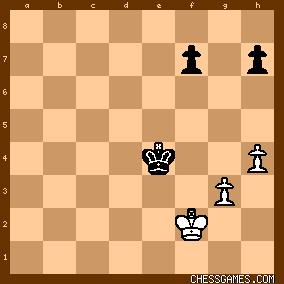
click for larger view (White to play, 46?) if I have visualised correctly.
Black's main threat is 46 ...h5! fixing the King side Pawns: e.g. 46 Ke2 h5! and Black
has the opposition.
White can however play 46 h5! intending to meet 46...Kf5 with 47 Kf3. Having the Pawns further forward
increases White's drawing chances.
It is not necessary to analyse every line in advance: one can look at the position over the board.
The tactic 38...Ra7 is clearly at least equalising: play it and think about the best continuation later.
Time to check:
=====
White finds the excellent equalising move 42 Rh5! instead of 42 h4? after which a draw is a very fair result. |
|
| Nov-03-09 | | njchess: I finally got 38. ... Ra7! but it took me (I reluctantly admit) the better part of five minutes to find it. No way for Black to checkmate so he must settle for a draw, which, given the position, is a good deal. |
|
| Nov-03-09 | | nd792001: Were I playing white, I would be deeply Fusterated with this result... |
|
| Nov-03-09 | | WhiteRook48: I tried 38...Rb4+? 39 e4 e5+?! |
|
| Nov-03-09 | | CHESSTTCAMPS: <David2009:> Nice try, but even if white plays as you suggested, black can't win this K & P ending unless white cooperates. I believe that you're envisioning a position like this, with white in zugswang: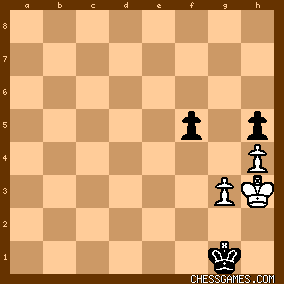
click for larger viewWhite is indeed lost here, but white can't be forced here. The white king can't be dislodged from f2 because the weakness of the split pawns prevents black from obtaining a meaningful opposition. To illustrate, let's age your position a bit:
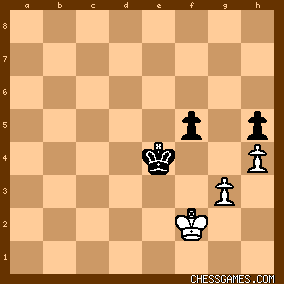
click for larger viewIf it's white to move 1.Ke2 f4 2.gxf4 Kxf4 3.Kf2 is drawn. If black is to move, 1... Kd3? is the only way to dislodge the WK from e2/f2 and that loses to 2.Kf3 |
|
| Nov-03-09 | | David2009: <CHESSTTCAMPS: [snip] black can't win this K & P ending> You are absolutely right.
This shows IMO the difficulty (for me) of visualising and appraising accurately a position several moves ahead.
I had my diagram "in my head" when I was composing the post. Once
the position is there in front of me it is easier for me. <the weakness of the split pawns prevents black from obtaining a meaningful opposition.>
Very well put. Thanks for taking the time and trouble to comment. |
|
| Nov-03-09 | | turbo231: Excellant puzzle. Mark me down as a dummy for missing ra7. Even though I'm a dummy I never would have played 37.f3 blocking my self in! But on the other hand I've done that and worse,far far worse. |
|
| Nov-03-09 | | Eisenheim: please see <yourang> and <once> for my thoughts on this. after the forced mate threat is realized it is a simple trick to spear the a pawn |
|
| Nov-03-09 | | koinonia: What about 38..e5+ 39. Rxe5 Rb4+ 40. Re4 fxe4? |
|
| Nov-03-09 | | CHESSTTCAMPS: <Jimfromprovidence:> Your 37.e4 is as good a try as any, but I believe the chances of winning this are slim against competent defense. To illustrate how big black's draw margin is (and to follow up on my question to <TheN>), I suggest that black can surrender the a-pawn immediately and still have no problem drawing. Suppose that from your 2nd position that the play continues 38... Rb7 39.Rxa5 Rb4+ 40.Kf3 Rb3+ 41.Ke4 Rb2 42.Kf3 Ra2 reaching the following position: 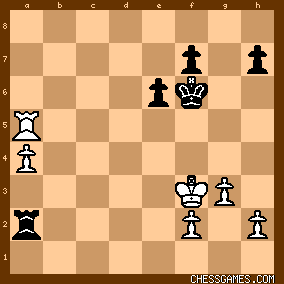
click for larger viewBlack has his rook in the ideal defensive position behind white's passed pawn and I can't find a reasonable winning idea for white. If white plays Ra8 followed by a5-a6-a7, black sets up an impregnable defensive position with K at g7 and P at h6 to avoid harrassment by white pawns. I welcome any ideas or suggestions for improvements. Related to this topic, there is a nice instructional video, intended for inexperienced endgame players, on the basic defensive rook behind ascending pawn ending at http://www.youtube.com/watch?v=eHb1.... |
|
| Nov-03-09 | | CHESSTTCAMPS: <David2009:> Yours was a great post, because it made us think and for a moment, I thought you might be right! Of course, visualizing and appraising become harder the deeper you go into the analysis tree, but tackling the puzzles this way definitely helps to improve both abilities. BTW, on Friday's puzzle, <YouRang> diagrammed one of the key positions I'd visualized and even after studying the diagram, I'm still not sure I've got the appraisal part right! |
|
| Nov-03-09 | | CHESSTTCAMPS: <koinonia:> <What about 38..e5+ 39. Rxe5 Rb4+ 40. Re4 fxe4?> White plays 40.e4 instead and should win. See my first post. |
|
Nov-03-09
 | | Jimfromprovidence: <CHESSTTCAMPS> <Your 37.e4 is as good a try as any, but I believe the chances of winning this are slim against competent defense.> It’s funny, because I wasn’t saying that 37 e4 was a winning move, but more that 37 f3 was a bad one. It immediately draws, because black has 37…Rc7, which is the same technique used in the puzzle solution; it’s just one move earlier.

click for larger viewI did watch the youtube video, which is very helpful. But in your position below, after 37 e4 fxe4 38 Kxe4 Rb7 39.Rxa5 Rb4+ 40.Kf3 Rb3+ 41.Ke4 Rb2 42.Kf3 Ra2, it gets tricky. 
click for larger view
There are more pieces on the board and because of the position of the pieces, it does not look evident that this is a drawn position, compared to the position in the video. White now has 43 Ra7, for example, which keeps the black king at bay.
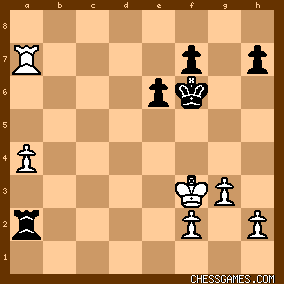
click for larger viewMaybe there is a win here, maybe there is not. |
|
| Nov-03-09 | | felixd: I tried to find a way for black to win but as I couldn't I decided to go with the simple but effective Ra7, which leads to a draw... |
|
| Nov-03-09 | | CHESSTTCAMPS: <Jimfromprovidence:> Sorry, I didn't mean to suggest that I thought you were claiming a win, just wanted to point out the difficulties with the defending rook behind the pawn. In any case, there do seem to be good winning chances for white in your diagrammed position. Playing black against Chessmaster (set to 30 sec/move) I'm 0-3, but undoubtedly I have not played the best defense. Deeper engine analysis may be in order. |
|
 |
 |
|
< Earlier Kibitzing · PAGE 3 OF 3 ·
Later Kibitzing> |





